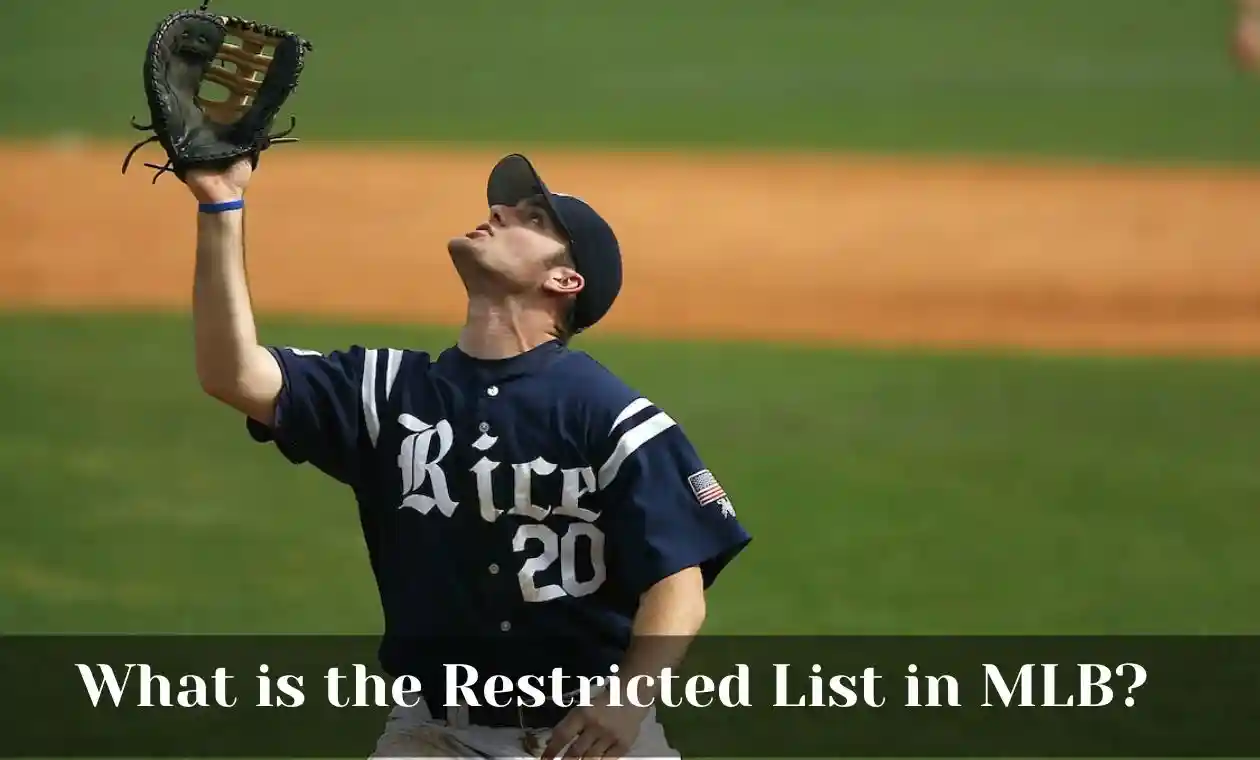
The MLB Restricted List is a distinctive status in Major League Baseball, serving as a holding place for players who are technically part of a team but are not actively participating. Unlike the Injured List or other roster categories, the Restricted List is specifically designed for unique situations where a player is unavailable for play. Let’s delve into this intriguing facet of baseball to understand its nuances.
At its core, the MLB Restricted List is a designation for players who remain part of a team but cannot actively contribute. It acts as a strategic tool for managing situations where players face challenges preventing them from playing or participating in team activities.
It’s essential to distinguish the Restricted List from other designations like the Injured List. While the Injured List is reserved for players with physical injuries affecting their ability to play, the Restricted List encompasses a broader spectrum of situations, including non-baseball-related absences and players contemplating retirement.
Players find themselves on the Restricted List for various reasons, such as unexcused absences, retirement contemplation, or other unusual circumstances. The most common scenario involves a player missing playing time without a valid reason, prompting the team to request placement on the Restricted List.
In the sections to follow, we’ll explore the specific rules, recent cases, and the impact of the Restricted List on both players and teams, shedding light on a critical aspect of MLB’s roster management.
Also Read: Baseball Bat Guide
Rules and Procedures
Now that we’ve grasped the essence of the MLB Restricted List, it’s crucial to unravel the specific rules and procedures governing this distinctive status.
Specific Rules Governing the MLB Restricted List:
The MLB has outlined stringent rules dictating the circumstances under which a player can be placed on the Restricted List. Primarily, this designation is reserved for players who might be unavailable for non-baseball-related purposes, often stemming from personal or legal issues. Understanding these rules is pivotal in comprehending the league’s approach to managing player availability.
Duration of a Player’s Stay on the List:
A pertinent question arises regarding the duration a player can stay on the Restricted List. Unlike some roster categories with predefined timelines, the Restricted List’s duration is contingent on the player’s unique situation. Whether they’re addressing personal matters, contemplating retirement, or facing unusual circumstances, the league allows flexibility in accommodating these diverse scenarios.
Reinstatement Process for Players:
Players on the Restricted List aren’t indefinitely barred from returning to active play. There exists a formal reinstatement process, providing players with an avenue to resume their careers. This process involves a thorough evaluation of the player’s situation, ensuring that their return aligns with the league’s guidelines and standards.
As we move forward, we’ll delve into specific cases, examining how these rules and procedures play out in real-life scenarios and exploring the implications for both players and their respective teams.
Also Read: Selecting the Perfect Baseball Bat
Recent Cases and Examples
Now, let’s shift our focus to real-life instances that exemplify the application of the MLB Restricted List, shedding light on both current and historical cases.
Current Players on the Restricted List:
As of the latest updates, several players find themselves on the MLB Restricted List, each with a unique set of circumstances leading to their placement. It’s essential to examine these cases individually to understand the diverse reasons that can prompt a team to utilize the Restricted List designation.
Circumstances Surrounding Their Placement:
Delving into the circumstances surrounding each player’s placement on the Restricted List provides valuable insights into the complexities of their situations. Whether it’s addressing personal matters, navigating retirement considerations, or facing unprecedented challenges, these instances offer a glimpse into the diverse factors that can lead to a player’s restricted status.
Historical Cases of Players on the List:
Beyond the current scenarios, historical cases provide a broader perspective on how the MLB Restricted List has been utilized over time. Exploring these instances allows us to identify patterns, changes in league dynamics, and the evolution of policies surrounding player eligibility.
In the next section, we’ll explore the consequences of being on the Restricted List, both for the players themselves and the teams managing their rosters. Understanding these implications adds depth to our comprehension of this unique facet of MLB’s operational framework.
Impact on Players and Teams
Now, let’s delve into the significant repercussions of a player finding themselves on the MLB Restricted List, exploring the consequences for both the individual player and the team they belong to.
Consequences for a Player on the Restricted List:
When a player is placed on the Restricted List, they face limitations on their active participation. This means they cannot play in games or engage in team activities, creating a period of hiatus from their usual role within the team. Understanding these consequences is integral to grasping the challenges and adjustments players on the Restricted List must navigate.
Salary Considerations for Players in this Situation:
One crucial aspect that directly impacts players on the Restricted List is the financial dimension. Unlike active players, those on the Restricted List do not receive their regular pay. The absence of income during this period can pose financial challenges for the affected players. This facet highlights the gravity of being on the Restricted List beyond the on-field implications.
Implications for the Team’s Roster and Overall Performance:
From the team’s perspective, the placement of a player on the Restricted List triggers a series of roster adjustments. As these players do not count towards the active roster or reserve list limits, teams need to fill their positions with other players. This dynamic has cascading effects on the overall performance and composition of the team, influencing strategies and gameplay.
In the subsequent section, we’ll explore how the MLB Restricted List compares to similar lists in other professional sports leagues, offering a broader context to its role in baseball’s operational framework.
Also Read: Top 10 Baseball Caps for 2023
Comparisons to Other Leagues or Sports
To gain a holistic understanding of the MLB Restricted List, it’s insightful to explore how it aligns with or diverges from similar lists in other professional sports leagues. Let’s embark on a comparative analysis, shedding light on the distinctive nature of MLB’s approach.
Investigating Similar Lists in Other Professional Sports Leagues:
A comparative examination necessitates a look beyond baseball, exploring analogous lists in sports leagues worldwide. Whether it’s the NBA, NFL, or international leagues, understanding how other sports organizations manage player availability provides valuable insights into the diversity of operational frameworks.
Analyzing MLB’s Restricted List in Comparison to Other Penalty Systems:
The MLB Restricted List, while unique in its own right, shares common ground with penalty systems in other sports. Drawing parallels and distinctions between these systems offers a nuanced perspective on how leagues address player-related challenges. Whether it’s addressing personal issues, contemplating retirement, or facing legal matters, the comparative analysis enriches our understanding of the broader sporting landscape.
As we conclude this exploration, we’ve unraveled the intricacies of the MLB Restricted List, from its definition and rules to real-life cases and its impact on players and teams. This comprehensive understanding positions us well to appreciate the role it plays in maintaining fairness and flexibility within Major League Baseball.
In Crux
In conclusion, the MLB Restricted List stands as a strategic tool, finely balancing the intricacies of player availability and team dynamics within Major League Baseball. Let’s recap the key points that underscore its significance:
The MLB Restricted List serves as a unique status for players facing situations that render them temporarily inactive. Whether due to personal matters, retirement contemplation, or other unusual circumstances, this designation allows teams to manage player availability with flexibility.
At its core, the Restricted List is a testament to the league’s commitment to fairness and operational adaptability. By providing teams with a designated space to navigate challenges, it ensures that players, even in unique circumstances, retain their rights while teams can make necessary adjustments without compromising roster limitations.
As we reflect on the intricacies of this facet of baseball, it’s evident that the MLB Restricted List plays a crucial role in maintaining the balance and integrity of the league. Its existence is a testament to the adaptability of Major League Baseball, offering a solution for scenarios that fall outside the realm of conventional roster designations.
This journey through the nuances of the MLB Restricted List enhances our appreciation for the complexities of managing a professional sports league, where considerations extend beyond the boundaries of the field.
Related Article –

Meet Daniel Anderson, the heart and soul behind Baseball Pro Picks. At 49, Daniel’s life has revolved around baseball, a passion that’s as strong today as it was when he first fell in love with the game. Living in the USA, Daniel has dedicated countless hours to watching, analyzing, and understanding every pitch, hit, and home run, making almost no game missed. His deep-rooted love for the sport is matched only by his commitment to sharing insightful, expert analysis with fellow baseball enthusiasts. With decades of experience and a keen eye for the game’s nuances, Daniel brings a unique perspective that enriches Baseball Pro Picks. Trust Daniel to guide you through the intricacies of baseball with the authority and trustworthiness of a true aficionado.












